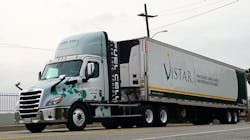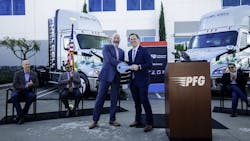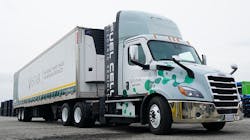Hyzon helps fleet cover its bases before implementing hydrogen fuel cell EVs
Running Class 8-sized routes with an electric truck is a tall order. Whether it’s finding a truck with the power to haul the load along with the weight capacity to bring a profit or being able to access/build charging infrastructure, fleets looking to electrify have their work cut out for them. Some fleets are finding Class 8 hydrogen fuel cell electric vehicles to fit the bill–and without sacrificing range.
About the Fleet
-
Performance Food Group
-
HQ: Richmond, Virginia
-
FO 500: Private: No. 18
-
Type: Food Products
Performance Food Group, No. 18 on the 2023 FleetOwner 500: Private, celebrated the delivery of four hydrogen fuel cell-powered electric trucks on Jan. 25, with a fifth truck to be delivered in March. The delivery took place at PFG’s Vistar facility in Fontana, California.
Jeff Williamson, the senior VP of operations at PFG, said the company chose the Hyzon fuel cell electric heavy-duty truck solution because of its range compared to a battery-electric heavy-duty truck.
See also: Bosch doubles down on hydrogen as key to trucking’s sustainable future
“The particular fuel cell vehicles that we're launching today... have a range between 300 and 350 miles, which is very suitable for the mix of routes that we have out of this facility and, quite honestly, many of our facilities,” Williamson told FleetOwner.
Although PFG just recently received its first FCEV truck purchases, this isn’t the first time the company worked with Hyzon’s fuel cell trucks. Williamson said PFG, a company with lofty ESG goals, started the process two years ago. Len Lamkin, PFG VP of transportation, began talks with Hyzon that led to “extensive testing” and a pilot program.
During the testing and the piloting, Williamson said PFG found aspects of the vehicle that needed to be addressed. “Len and his team kept pushing for more power to extend that range and addressing any potential issues we had,” Williamson told FleetOwner, and “Hyzon jumped all over those.”
PFG’s new hydrogen fuel cell trucks join dozens of others in operation. Nikola Corporation sold 35 FCEV Class 8 trucks in 2023. Nikola recently opened its first Hyla H2 fueling station in Ontario, California. There are also several Kenworth FCEVs in California drayage pilot operations. Kenworth parent Paccar plans to start producing Kenworth and Peterbilt FCEVs by 2025.
Implementing a seamless maintenance and fueling plan
The Hyzon HYHD8-110 has a fuel cell power of 110 kW and continuous 1,180 lb.-ft. electric motor torque with 1,770 lb.-ft. of peak torque. The truck rests on a Freightliner Cascadia chassis.
See also: Hyliion on track for Hypertruck production in 2023; plans fuel cell truck with Hyzon
Having an alternative fuel powertrain within a familiar chassis makes adopting alt-fueled vehicles a little more “seamless” for fleets, Parker Meeks, Hyzon CEO, told FleetOwner.
“We do use a base vehicle that is a familiar truck that they already have,” Meeks said. “A third-party assembler ... upfits our technology and all the componentry into the truck, (and that) also makes service a lot easier.”
This allows fleets to use their existing service approach, such as “a third-party service provider, the dealership, dealer network, and/or their own techs,” Meeks said. If a fleet chooses to service a Hyzon truck using their own technicians, Hyzon will subcontract their high-voltage technicians to train a fleet customer’s technicians, ensuring safety and support for the fleet.
In addition to making maintenance seamless, Hyzon also helps fleets with fueling. According to Meeks, Hyzon’s goal with fueling infrastructure is to mimic how many fleets already fuel their vehicles—either with fuel card partnerships or wet hosing services.
With a diesel fueling setup, fleets aren’t “working with large energy companies trying to figure out infrastructure installation on their location and costs,” Meeks said. Therefore, to continue the seamless transition to hydrogen fuel cell-powered vehicles, Hyzon steps in and offers its customers help.
“We actually have the capability to help our fleets with a fueling site,” Meeks told FleetOwner. “We've actually set up partnerships with major fuel providers ... to bring those solutions to them.”
PFG currently fuels its fleet at its own truck yard. “Putting hydrogen fuel in place at the scale that (PFG needs) starts with a mobile fueler,” Meeks told FleetOwner.
Pilot, using a mobile fueler, provides the on-site fueling for PFG and will be able to fill the fuel cell truck tanks within 10 to 15 minutes. Should PFG add more Hyzon trucks to its fleet, Meeks said the companies will all work together to ensure an on-site hydrogen fueling infrastructure is established.
What’s in store for the future?
PFG is a national company with a private fleet that includes roughly 8,000 power units and 9,000 trailers. Along with the fuel cell vehicles that were just delivered to PFG’s Vistar facility, the company also uses battery-electric vehicles and battery-electric refrigerated trailers at other facilities. As far as building out a fleet full of EVs, Williamson said the fleet looks to employ a “mixture” of powertrains.
“Overall, we are pleased with everything that we have in service today,” Lamkin told FleetOwner. “The challenge is, they all have different types of capabilities, different ranges, different recharge periods. We're trying to figure out what the balance is to meet the various needs of our business.”
Williamson said, however, he does see fuel cell electric vehicle technology growing at a “significant” rate.
See also: Hydrogen vs. BEVs: Reaching energy independence
Advice to others
Fleets interested in adding EVs to their operations, whether battery electric or fuel cell electric, must first decide what powertrain will best fit their operation, Meeks said. They also have to take fueling or charging infrastructure into account.
As many fleets with plans for substantial EV implementation have already experienced, when they approach their utility to talk about building charging infrastructure, “you're talking five-plus years to get that much power (to your facility)," Meeks said.
Fleets can also use outside help when determining what powertrain is the best fit, Lamkin said, and one way to facilitate that is to ask representatives from multiple battery-electric vehicle and fuel cell electric vehicle OEMs to assess the fleet’s operation.
“You really need to do a lot of your homework to understand how's it going to operate in your space, and what is the most applicable situation for your business,” Lamkin explained. “Get plenty of opinions from plenty of manufacturers and other peer groups that are using (alternative fuel) technologies, as well.”
Additionally, Williamson warned fleets to ensure the OEM they’ve ordered trucks from can deliver—on the trucks and their promises to help integrate them into the business.
About the Author
Jade Brasher
Senior Editor Jade Brasher has covered vocational trucking and fleets since 2018. A graduate of The University of Alabama with a degree in journalism, Jade enjoys telling stories about the people behind the wheel and the intricate processes of the ever-evolving trucking industry.



